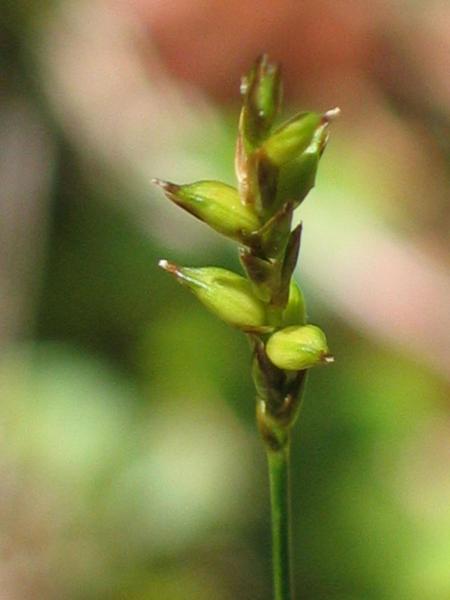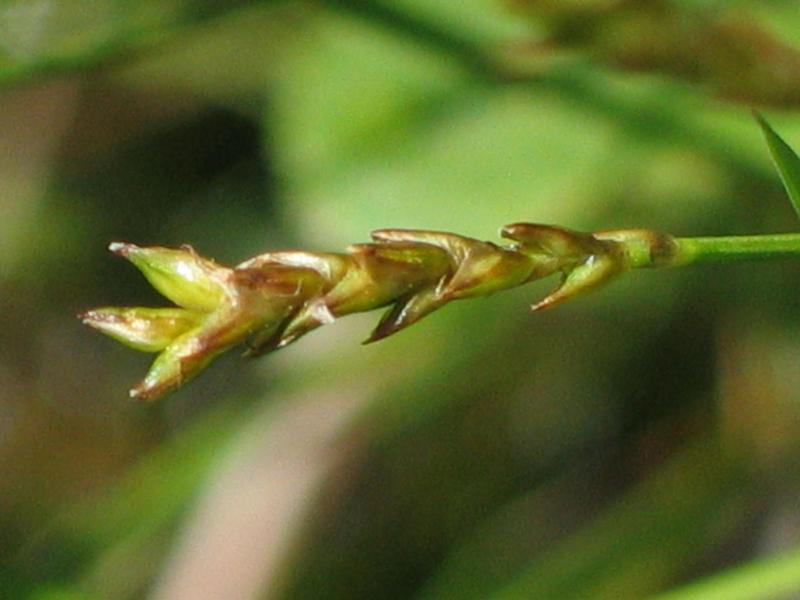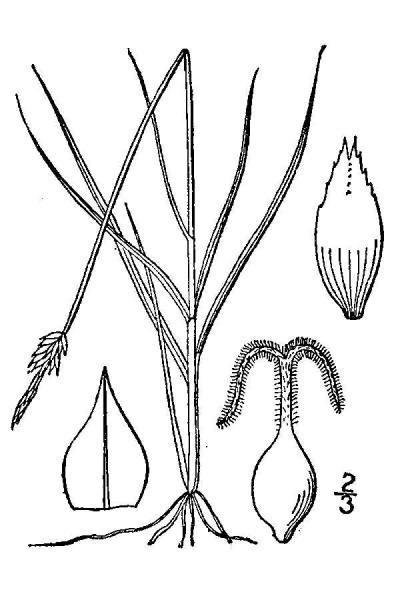Northern Bog Sedge
Carex gynocrates Wormsk. ex Drej.
- Class
- Monocotyledoneae (Monocots)
- Family
- Cyperaceae (Sedge Family)
- State Protection
- Endangered
Listed as Endangered by New York State: in imminent danger of extirpation in New York. For animals, taking, importation, transportation, or possession is prohibited, except under license or permit. For plants, removal or damage without the consent of the landowner is prohibited.
- Federal Protection
- Not Listed
- State Conservation Status Rank
- S1
Critically Imperiled in New York - Especially vulnerable to disappearing from New York due to extreme rarity or other factors; typically 5 or fewer populations or locations in New York, very few individuals, very restricted range, very few remaining acres (or miles of stream), and/or very steep declines.
- Global Conservation Status Rank
- G5
Secure globally - Common in the world; widespread and abundant (but may be rare in some parts of its range).
Summary
Did you know?
The specific epithet gynocrates means dominant female which is in reference to the stout female spikes (Fernald 1970).
State Ranking Justification
There are only two known populations of this plant, one being discovered in 2005, and at least six historical locations that need further survey work. This plant tends to form large stands with hundreds to thousands of culms. In New York it is a sedge of calcareous wetlands, a very limited habitat type. It may be threatened by changes to hydrology, water chemistry changes, and invasive species
Short-term Trends
There are only two populations that have been seen in recent years. One of these populations was first found in 2005. It was probably overlooked in the past. The other population is large and healthy but no exact data is available on the trends. Therefore, short term trends are not clear but might indicate that this species is currently stable.
Long-term Trends
One population has been known for at least 140 years. Another populations was just discovered in 2005 but it was probably overlooked in the past. There are approximately seven or so additional populations that are only known from historical documentation. It is unknown if these populations are still extant. Overall, long term trends are unknown.
Conservation and Management
Threats
The two extant populations in New York are not currently threatened. This species does occur in very specific habitats that can be negatively impacted if the hydrology or water chemistry changes. Additionally, invasive species are a potential threat but currently do not seem to be significantly impacting the populations.
Conservation Strategies and Management Practices
No management actions are currently needed.
Research Needs
Surveys to all historical populations should be conducted to assess whether these populations are still extant.
Habitat
Habitat
Carex gynocrates grows on hummocks and bases of trees in rich Thuja occidentalis dominated swamps. In these swamps, it is often found in openings or where the canopy is thin. It prefers strongly calcareous areas often near more open rich fens (New York Natural Heritage Program 2006). Wet peaty ground, usually in openings in coniferous swamps and conifer-hardwood stands, less often in poor fens, boggy swales (flarks) and alder thickets, also subalpine meadows, tundra, outwash gravel and seepage areas, usually on calcareous substrates (Cochrane 2002). Circumneutral fens (Haines and Vining 1998). Sphagnum bogs (Gleason and Cronquist 1991). Bogs, boggy shores, and openings in boggy woods (cedar swamps, etc.) often in sphagnum (Voss 1972).
Associated Ecological Communities
- Northern white cedar swamp
(guide)
A swamp that occurs on organic soils in cool, poorly drained depressions in central and northern New York, and along lakes and streams in the northern half of the state. These swamps are often spring-fed with continually saturated soils. Soils are often rich in calcium. The characteristic tree is northern white cedar, which makes up more than 30% of the canopy cover.
- Red maple-tamarack peat swamp*
(guide)
A swamp that occurs on organic soils (peat or muck) in poorly drained depressions. These swamps are often spring fed or enriched by seepage of mineral-rich groundwater resulting in a stable water table and continually saturated soil. The dominant trees are red maple and tamarack. These species usually form an open canopy (50 to 70% cover) with numerous small openings dominated by shrubs or sedges.
- Rich shrub fen*
(guide)
A wetland with many shrubs that is usually fed by water from springs and seeps. These waters have high concentrations of minerals and high pH values, generally from 6.0 to 7.8. Plant remains in these fens do not decompose rapidly and thus the plants in these fens usually grow on older, undecomposed woody plant parts.
* probable association but not confirmed.
Associated Species
- Carex interior (inland sedge)
- Carex vaginata (sheathed sedge)
- Larix laricina (tamarack)
- Thuja occidentalis (northern white cedar, arbor vitae)
- Valeriana uliginosa (marsh valerian, swamp valerian)
Range
New York State Distribution
Carex gynocrates is known from the northern parts of western and central New York to the western part of northern New York.
Global Distribution
Carex gynocrates occurs in North America and eastern Asia. It is mostly a boreal plant that becomes rarer southward. In North America it occurs from Alaska, Nunavut, and Greenland south to Nova Scotia, Maine, New York, Pennsylvania (one historical colllection), Michigan, Wisconsin, Minnesota, Nebraska, Colorado, Utah, and Oregon (Cochrane 2002).
Identification Comments
General Description
Northern bog sedge is a very fine grass-like perennial that grows in patches. Stems occur scattered along thread-like rhizomes and are 2-30 cm tall. Leaves are wispy and less than 1 mm wide. Stems have one flower/fruit cluster (spike) at their apex. These spikes vary from being composed of entirely male flowers, entirely female flowers, or having male flowers above and female flowers below. Fruits (perigynia) are 2.9-3.4 mm long (Cochrane 2002).
Identifying Characteristics
Carex gynocrates is long rhizomatous and colonial. Reproductive culms that are 2-30 cm tall, are produced singly or in twos or threes along rhizomes that are 0.3-0.8 mm wide. Leaves are filiform and 0.3-0.7 mm wide. The inflorescences are composed of one terminal spike. These spikes vary from being completely staminate to completely pistillate to androgynous with most being completely pistillate. Perigynia are ascending when immature and become spreading to reflexed at maturity. They are biconvex, 2.9-3.4 mm long, and have a beak 0.5 mm long (Cochrane 2002).
Best Life Stage for Proper Identification
It is easiest to identify this sedge when it has immature to mature perigynia although, plants in flower are relatively easy to identify as well.
Similar Species
Carex gynocrates is a very distinctive species. It can be distinguished from all other species by its one spike per culm, long rhizomatous and colonial habit, and its perigynia which are biconvex in cross section.
Best Time to See
Immature perigynia start in early June or occasionally earlier. They persist till late July or sometimes later. During the later part of this season the perigynia start to shed. Therefore, the best time to survey for this species is from June till mid July.
- Fruiting
The time of year you would expect to find Northern Bog Sedge fruiting in New York.
Northern Bog Sedge Images
Taxonomy
Northern Bog Sedge
Carex gynocrates Wormsk. ex Drej.
- Kingdom Plantae
- Phylum Anthophyta
- Class Monocotyledoneae
(Monocots)
- Order Cyperales
- Family Cyperaceae (Sedge Family)
- Order Cyperales
- Class Monocotyledoneae
(Monocots)
- Phylum Anthophyta
Synonyms
- Carex dioica ssp. gynocrates (Wormsk. ex Drejer) Hultén
- Carex dioica var. gynocrates Wormsk. ex Drej.
- Carex gymnocrates auct. non
Comments on the Classification
Carex gynocrates is very closely related and is sometimes treated as a subspecies or variety of C. dioica. Carex gynocrates is a member of section Physoglochin which has up to six species two of which occur in North America. Carex gynocrates is the only member that occurs in New York. Carex gynocrates is known to hybridize with C. maritima but the latter species as well as hybrids are not known from New York.
Additional Resources
Best Identification Reference
Gleason, Henry A. and A. Cronquist. 1991. Manual of Vascular Plants of Northeastern United States and Adjacent Canada. The New York Botanical Garden, Bronx, New York. 910 pp.
Other References
Cochrane, T.S. 2002. Carex Linnaeus sect. Physoglochin Dumortier. Pages 299-301 in Flora of North America Editorial Committee (editors), Flora of North America, North of Mexico, Volume 23, Magnoliophyta: Commelinidae (in part): Cyperaceae. Oxford University Press, New York, New York, USA. 608pp + xxiv.
Fernald, M.L. 1950. Gray's manual of botany. 8th edition. D. Van Nostrand, New York. 1632 pp.
Haines, A. and T.F. Vining. 1998. Flora of Maine, A Manual for Identification of Native and Naturalized Vascular Plants of Maine. V.F.Thomas Co., Bar Harbor, Maine.
Holmgren, Noel. 1998. The Illustrated Companion to Gleason and Cronquist's Manual. Illustrations of the Vascular Plants of Northeastern United States and Adjacent Canada. The New York Botanical Garden, Bronx, New York.
New York Natural Heritage Program. 2010. Biotics database. New York Natural Heritage Program. New York State Department of Environmental Conservation. Albany, NY.
New York Natural Heritage Program. 2024. New York Natural Heritage Program Databases. Albany, NY.
Reschke, Carol. 1990. Ecological communities of New York State. New York Natural Heritage Program, New York State Department of Environmental Conservation. Latham, NY. 96 pp. plus xi.
Voss, E.G. 1972. Michigan Flora, Part I. Gymnosperms and Monocots. Cranbrook Institute of Science Bulletin 55 and the University of Michigan Herbarium. Ann Arbor. 488 pp.
Weldy, T. and D. Werier. 2010. New York flora atlas. [S.M. Landry, K.N. Campbell, and L.D. Mabe (original application development), Florida Center for Community Design and Research http://www.fccdr.usf.edu/. University of South Florida http://www.usf.edu/]. New York Flora Association http://newyork.plantatlas.usf.edu/, Albany, New York
Links
About This Guide
Information for this guide was last updated on: May 31, 2006
Please cite this page as:
New York Natural Heritage Program. 2024.
Online Conservation Guide for
Carex gynocrates.
Available from: https://guides.nynhp.org/northern-bog-sedge/.
Accessed July 26, 2024.


